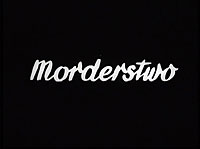 Morderstwo
Morderstwo
Poland, 1957, black and white, 1 min
Some artists find their characteristic themes and approaches some distance into their career, while others emerge seemingly fully formed. Roman Polański so unambiguously falls into the latter group that the authorship of his first batch of Łódź Film School shorts (literally the first films he ever made, aside from an abandoned project called Bicycle/Rower from 1955) could be guessed almost without prompting.

Murder (also known as The Crime) was the first, the shortest and the simplest. It consists of three shots: a man enters a room and walks across to a bed where another man lies sleeping, his chest bared; the first man takes a small penknife out of his pocket and stabs the sleeper; as blood trickles down the now dead sleeper’s arm, the murderer leaves the room. There is no context, no motivation, and while the film’s unnerving silence was presumably dictated by budget/logistical reasons, the absence of a soundtrack has the effect of heightening the sense of voyeurism: we’re watching from a distance, too far away to hear, and quite unable to help.
Polański rarely tackled his wartime experiences directly on film – the short Where Angels Fall (Gdy spadają anioły, 1959) and, much later, the feature The Pianist (2002) being the only exceptions. But Murder powerfully conveys a situation that Polański must have been in many times in real life: both a helpless and appallingly fascinated witness to innumerable atrocities, where intervention would have meant the same thing happening to him (a certainty, given that Polański was a Jew in hiding for much of the war). The mere fact that the stabbing itself is so matter-of-fact (instead of the usual theatrical flourish, the murderer simply flips open a penknife, places it over the victim’s breast and uses both hands to push it down) heightens the horror: shouldn’t something so terminal be more demonstrative? Especially since this act is the entire focus of the film?

Three years before Alfred Hitchcock and Michael Powell explored the notion of sudden, violent death coming out of the blue in Psycho and Peeping Tom (both 1960), Polański was tackling similar material, but with none of the elaborate psychological framework constructed by the others to explain/justify their murderers’ actions. It’s presumably not an accident that we get a good look at the murderer’s face as he leaves: a chubby but otherwise nondescript man, he doesn’t remotely resemble the lean and hungry psychopath of the conventional image. Is he a hitman, “only obeying orders”? A spurned lover seeking revenge? There’s no way of knowing – Polański certainly isn’t telling, as he devotes just one sentence to the film in his autobiography, dismissing it as a technical exercise. Maybe so, but it’s a highly revealing one.
- Director: Roman Polański
- Photography: Nikola Todorow
- Production Company: Łódź Film School (PWSF)
DVD Distribution: Murder is included in the four-disc box set The Roman Polanski Collection (UK, Anchor Bay, Region 2 PAL) and Roman Polanski: Sept Courts-Métrages (France, Wild Side, Region 2 PAL). This review is of the Anchor Bay version.
Picture: Given its student-film origins, the print is in surprisingly good condition – there’s a modicum of surface damage (white dust spots and a faint tramline skittering across the frame), but the underlying image is perfectly clear. Any defects are likely to be inherent in the original materials.
Sound: The film is totally silent.
Subtitles: None supplied, none necessary (there is no dialogue, and the only onscreen text consists of the title and rudimentary production credits).